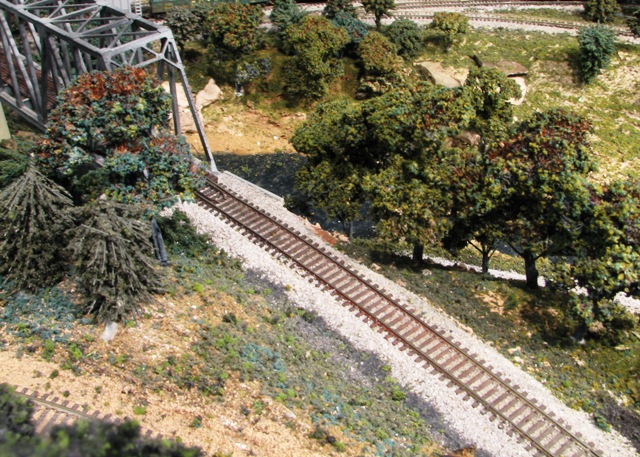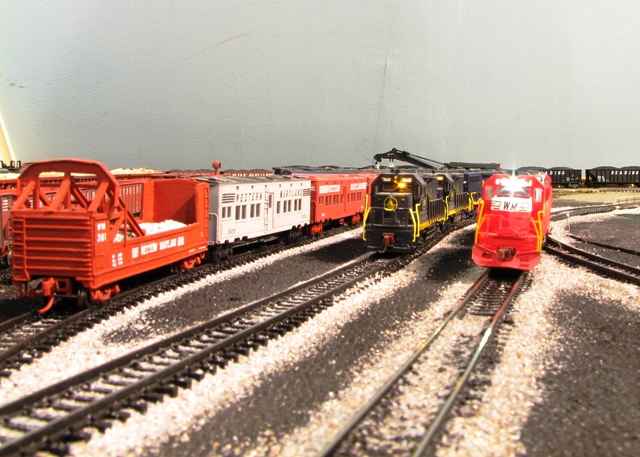I already know about the hight diffrences in the rail, but what what I’m asking is am I better off using code 80? Will most n scale locomotives run on code 55? Which ones/brands don’t?
From what i know, there both good. Code 80 has been around for a long time, is reliable and is tough. Code 55 is better looking . If you are going to run very fineky steam locos, i would use code 80. But if you do go with code 55, make shure you do not have any deep flange wheelsets. Absoulty will not work. If your new and have tolorable locos, use code 80. If you are still not shure, get some code 55 track and test some of your locos on it. It could not hurt. Also, if it helps, i am using code 80 now and i have not had one problem yet.
Are you better off? Tough question.
Do you have alot of rolling stock with pizza cutter wheels? With code 55 , you will need to change the wheel sets to low profile ones. That is an added expense. Switching trucks to Microtrains trucks will require the replacement of the wheel sets also. Older locos might be a problem too, depending on how old.
I only buy Atlas and Kato engines, these do not have any problems with code 55. Again, older stuff might be a problem but none of the newer stuff is. I can’t tell you about the other brands.
Atlas Code 55 has a better selection of switches than their code 80. They will require the additional purchase of switch machines or ground throws or you can even fabricate your own. Again, an added expense.
You really need to decide for yourself what look you want and how much are you willing to spend.
I went with Atlas code 55 for my railroad.
Craig
Based on my own experience,code 80 is the safest gauge as it will accept any N scale loco and rolling stock you may have.I’ve worked with only two brands so can only comment these and so it goes…
Atlas code 80 is sturdy and,if installed properly,will yeld trouble-free operation.However,only one rail slides in the ties,so that you have to take care to install this one on the inside in curves.On the other hand,they have bored ties for spikes wich is a nice feature.Also,turnout selection is limited and as been said,you’ll need some external device to switch them.There are turnouts called “Snap-Switches” that I personally don’t recommend.
Peco code 80 track is comparable in every way with minor differences.First,the two rails slide in the ties wich may ease adjustment while installing but do not feature spike holes in the ties,so you have to drill some yourself or glue your track down.Where Peco shines though is in that they offer a wider choice of turnouts(three different radiuses,double crossovers,wyes,etc) along with a strong twin-coil motor that attach directly to the turnout for firm operation.Peco turnouts are self-locking as a spring makes sure they stay put after being switched,so you may have to remove this spring if you want to use another type of switching motor.These turnouts come in two types,Electrofrog and Insulfrog.The Insulfrog type doesn’t require any special installation care and unless you care about the plastic frog’s looks or intend to run very short locos,they’ll get the job done very nicely.
Atlas code 55…looks outstanding but will not accept deep flanged wheels.Since I haven’t installed any of these,I can’t tell you more.I don’t know about the turnout availability of this type either.
Peco code 55…my personal choice for my layout.They are in fact code 80 tracks buried a little deeper in the ties so that they somewhat look like code 55 but can accept most if not all N scale
Atlas code 80, Peco code 80, and Peco code 55 can be mixed. I use Peco code 80 switches with Atlas or Peco code 80 track on main lines and Peco code 55 track and switches on sidings and spurs.
Because of the the design of Atlas code 55, deep flanged wheels hit the “spikes” . Some other brands of code 55 have less trouble with deep flanges.
Code 55 looks better than code 80 and shallow flanged wheel look better than deep flanges. Code 55 (except Peco code 55) is more fragile than code 80. Cafefully laid code 55 is as reliable as code 80.
How about Micro-Engineering Code 70 or 55? I used their Code 70 stuff years ago and was pretty happy with it, but it seems nowadays their selection of turnouts is somewhat limited.
It all depends on what you want to use it for. My layout goes to train shows so i use code 80 mostly for the toughness but i also use code 55 for some of the switching to make the look of hight differences like they would have in real life.
In N scale there are indeed many choices of track available.
If you are running older equipment (with larger flanges) your selection will be limited a little. Running DCC will cut the field a little more.
Basically it breaks down like this (or so I understand);
Atlas code 80 - the old standby. It’s bullet proof, cheap, easy to find, and DCC friendly. It just doesn’t look the greatest (tall rail, oversize ties and tie spacing and so forth). If you don’t mind the looks, it is OK. Good ballasting work, painting and weathering the rails can help a lot with the looks.
Atlas code 55 - Looks good, pretty easy to find, decent price, DCC friendly. They offer wye turnouts, # 10 turnouts, and various crossings. Problem is, older equipment has larger flanges on the wheels and they hit the ties on this track. This may not work for you. If you’re buying currently available equipment this will be less of an issue for you, except with Micro-Trains cars. You’ll have to get low profile wheelsets for those.
Atlas code 65 track - It’s one of those that has the roadbed attached to it, so it has those limitations. Also, there’s no flex track that I know of in that code. It’s new enough that there aren’t many options available yet, but who knows. Atlas made it because they a track / roadbed combo, and they made it code 65 so they could avoid the flange issue while still being somewhat close to a prototype rail height.
Peco code 80 and code 55 - Great stuff, lots of track choices (curved turnouts, Stub turnouts, slip switches, and all kinds of stuff), solid and reliable. The code 55 is really code 80 track with a double flange on the lower sides and it’s buried in the ties further. It doesn’t have any flange issues so you can run older and large flanged equipment without worry. Problems -
That’s a great synopsis, Phil.
For me it depends on what your end game is. If you want to build a detailed and realistic model railroad, then you’re going to prefer better looking track. Code 55 by itself doesn’t guarantee this. Peco makes a code 55 track, but the tie spacing and size is still very out of scale.
Atlas and Micro Engineering c55 have a superior appearance, but each has its own compromises. ME offers fewer turnout sizes, and is less readily available. Atlas has a cost advantage, and can be found more widely, but as others have noted, it’s not as friendly to “Heritage Fleet” equipment from the 70’s and 80’s.
My opinion is that if you want to better appearance of code 55, then you’re not going to accept the appearance of gigantic flanges on your cars anyway. It’s also significant to note that Atlas c55 complies with NMRA practice, while Micro Trains pizza cutters do not.
The key to any track is taking care to install it properly. Align your rail joints, provide for plenty of electrical leads, and make sure your turnouts work properly, and you’ll have years of trouble free service from any track.
Lee
I’m a bit confused … [%-)]
How can track be DCC “friendly” or “unfriendly” ??? [%-)]
I can see how a turn-out might have issues regarding DCC-friendliness. But plain old regular track ??? [%-)]
Can someone shed some light on that ?
You’re right, I meant turnouts. Sorry if I was unclear on that. I should have said that a bit more percisely.
I have been trying to think of a good way to word this! This is exactly my opinion regarding N-scale track and is why I am using Atlas & Micro Engineering code 55 for my new layout. I would use Atlas exclusively but they do not offer a concrete tie track product. Jamie
I’m kind of sorry Shinohara has gotten so hard to find nowadays. I used it a bit in the old days and thought it was pretty nice. And they had turnouts to die for. 3-Way, single and double slips. Sweet. All that and Code 70, which wasn’t bad, but granted not as good as the C55 stuff now.
Philip,
Thanks for clarifying that. [:)] I thought that’s what you meant; but just wanted to be sure. [8D]
To give you a visual…

Atlas c-55

and Atlas C-80.
Painted and ballasted, the c-80 is passable, but the c-55 looks much better overall, and when it’s painted and ballasted, it’s downright beautiful.
Lee